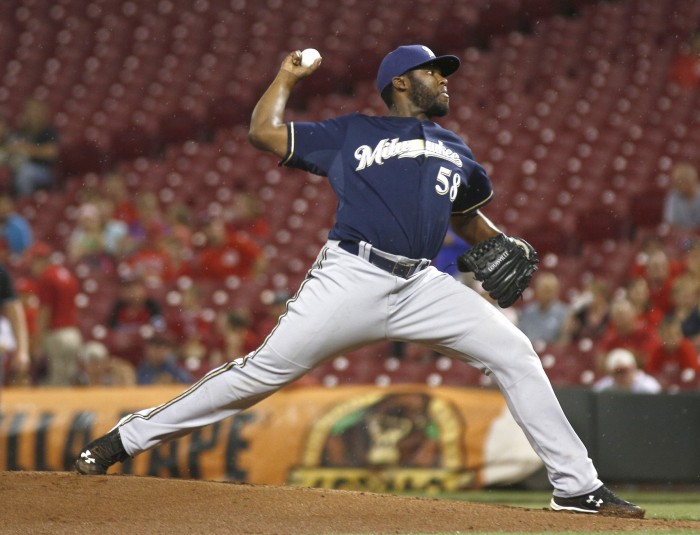For me, the most frustrating element of the 2015 Brewers has been that they’ve paired a generally exquisite bullpen with a putrid starting rotation. The fourth-best relief DRA in baseball means Milwaukee has sustained most of the leads it’s taken into the late innings; the fifth-worst starter DRA in baseball means those leads haven’t occurred very often. A few of the team’s relievers have recent experience beginning games — Will Smith and Michael Blazek served as Triple-A swingmen in 2013 and 2014, respectively — but few of them have demonstrated an ability to consistently take the mound every fifth day.
Enter Ariel Pena. He came to the Brewers three years ago in the Zack Greinke trade and, until about a month ago, had remained in their farm system ever since. That changed after a rainy series in Cincinnati, which depleted the team’s depth and forced it to dig into the minors. Pena came up, received an opportunity to start, and did well enough to see a few more turns through the rotation.
The right-hander has made four total starts in 2015, in which he’s held his own, allowing eight runs in twenty innings for a 3.60 ERA. His 3.86 overall DRA, while not exceptional, certainly tops the unsightly marks that his rotation comrades have posted. There’s the potential here for a satisfactory starting pitcher in 2016 and beyond; however, he’ll need to improve some things for that to happen.
Of the three pitches in Pena’s arsenal — a four-seam fastball, a changeup, and a slider — the latter clearly reigns supreme. The slider has induced a whiff on 26.1 percent of its usages, has gone for a ground ball on 50.0 percent of its trips to the field, and overall possesses a .138 TAv against. Implementing this deadly offering for 33.1 percent of his pitches has certainly helped Pena achieve what he’s achieved.
Interestingly, Pena’s slider hasn’t stood out in terms of velocity or movement:
| Pitcher | Velo | HMov | VMov |
|---|---|---|---|
| Pena | 84.0 | 0.1 | 2.2 |
| MLB | 84.3 | 1.7 | 1.3 |
As opposed to, say, Smith’s slider — whose bite allows him to blow it past any kind of hitter — Pena’s has seemed to become dominant by contrasting with his fastball, which has run an incredible amount:
| Pitcher | Velo | HMov | VMov |
|---|---|---|---|
| Pena | 92.7 | 7.1 | 9.8 |
| MLB | 92.4 | 1.7 | 9.1 |
Pena has consistently placed the slider in the lower right of the zone; the four-seamer has gone there somewhat often, but Pena has kept its usage unpredictable, elevating the slider in the process.
While its results obviously trail those of the slider, the four-seamer hasn’t exactly failed Pena. Sure, he’d probably like a higher rate of strikes than the 59.4 percent clip it’s provided, but he can’t complain about 8.0 percent swinging strikes and 10.4 percent popups. Overall, the pitch gives him a solid offering to use 62.0 percent of the time; along with the slider, it makes for a pretty good 1-2 punch.
So what’s the issue here? Well, Pena’s third pitch — the changeup — hasn’t shown anything resembling competence in its brief trials. Appearing 4.9 percent of the time thus far, it’s put up a 55.0 percent strike rate and a 0.0 percent whiff rate. Most hurlers need to have at least three decent pitches to make the cut as a starter, and those numbers fall far short of that standard.
The changeup’s failure becomes more pertinent when we consider Pena’s platoon split. This season, he’s held right-handers down to a .202 TAv, but lefties have knocked him around to the tune of a .329 TAv. His disparate pitch mix against them accounts for most of that:
| Handedness | Fourseam | Slider | Change |
|---|---|---|---|
| RHH | 59% | 40% | 1% |
| LHH | 67% | 22% | 11% |
In general, sliders will have heavy platoon splits, while changeups can neutralize them. Pena, recognizing this, has essentially made the changeup a lefty-only pitch; the pitch’s aforementioned output tells you how well that plan has worked for him. If he wishes to stick as a starter, Pena will need something that can retire left-handed batters — meaning he’ll either have to better his changeup or experiment with another pitch, such as a more overhand curveball.
In the end, Pena clearly has the potential to remain in the show — any pitcher with a slider this phenomenal can’t stay in the minors for long. With that said, a sole elite offering does not a capable pitcher make. Pena must progress with his changeup to stay afloat, lest he become a lowly LOOGY. Pena may yet help the Brewers’ rotation return to respectability; it all depends on where he goes from here.

1 comment on “Can Ariel Pena Stick in the Rotation?”